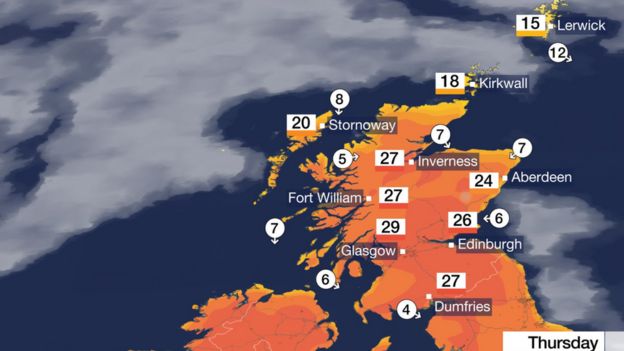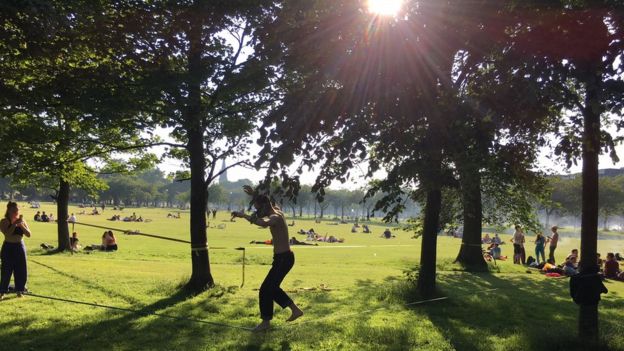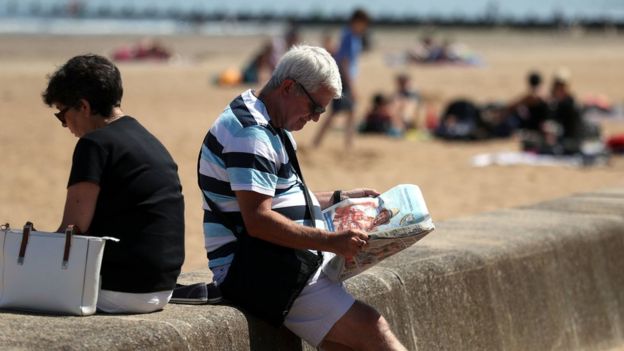
Scotland is enjoying another day of blazing heat and is approaching record temperatures last seen in 1893.
BBC forecasters say the June record of 32.2C in Ochertyre in Perth and Kinross in 1893 could be broken, with Glasgow one of the main hotspots.
Temperatures have triggered speed restrictions on rail routes and police and health board safety warnings.
And the “weatherproof” membrane on Glasgow Science Centre roof melted and dripped down the building.
At 15:00 a temperature of 31C was recorded in the city.
‘Black goo’
Sharon Lyons from Glasgow Science Centre said: “As Scotland enjoys ‘taps aff’ weather, the weatherproof membrane from our roof is quite literally melting.
“The structural integrity of the roof is completely sound, but we are left with a bit of an unsightly black goo on the roof.
“When we return to typical Glasgow colder climes, we shall set about cleaning it.”
Wednesday was the hottest June day in more than 20 years. Aviemore reached 31C, making it the hottest single day in five years.
The wettest place in the UK on Wednesday was Aultbea, a small fishing village in the north-west Highlands. However, it only had 0.2mm (0.07in) of rain.
- How hot is it where you are?
- When is it too hot to work?
- Staying safe and cool in UK heatwave conditions
Last year’s highest June temperature was 27.3C which was recorded at Floors Castle in the Borders.
 Image copyrightCAMPERDOWN WILDLIFE CENTRE
Image copyrightCAMPERDOWN WILDLIFE CENTREBBC Scotland weather presenter Kawser Quamer said: “Yesterday was the warmest June day in 23 years. Today we are likely to beat that.
“We could be looking at temperatures of 32C in Glasgow.”
Train services between Glasgow Central and Lanark were facing disruption for most of Thursday, the morning after major signalling problems caused issues on commuter routes.
‘Rails buckling’
ScotRail said this was because of speed restrictions due to high track temperatures.
Network Rail activated its “extreme weather action team” (EWAT).

David Dickson, Network Rail’s infrastructure director for the ScotRail Alliance, said: “On very sunny days, rails in direct sunshine can be as much as 20 degrees centigrade above air temperature causing the steel to expand markedly and could, if not carefully monitored and action taken, buckle causing travel disruption.
“Our engineers and specialist extreme weather teams are monitoring track-side temperatures and vulnerable locations and will, if necessary, introduce temporary speed restrictions during the hottest part of the day to keep trains running, albeit more slowly than normal.”
Some rails have been painted white to absorb less heat.
Other warnings have also been issued ahead of the increase in temperature.
Police have reminded people to be careful around water, particularly quarries, as the fine weather continues.
They issued a warning on Twitter, saying: “Some quarry lakes may look inviting on a hot summer’s day, but there are a number of hidden dangers! Deep water, submerged abandoned machinery & car wrecks, underwater recesses, hidden currents, dead animals, pollution.”
The message added: “More dangers of quarry swimming are sheer faces, falling rocks, quick sand, and believe it or not hypothermia – despite the weather, water deeper than a few inches will be cold enough to cause cold shock!”
 Image copyrightBBC WEATHER WATCHERS/GRAHAM
Image copyrightBBC WEATHER WATCHERS/GRAHAM Image copyrightPA
Image copyrightPANHS Dumfries and Galloway has sent out guidance on the risk the heat may cause to people’s health.
Dr Nigel Calvert said: “When we get hot and sunny weather like this, many people will head outdoors and make the most of it.
“It’s important to remember though that, for some, temperatures like these, over more than a day or two can be really uncomfortable and pose a risk to health.
“People who may be at risk include the over 65s, young children and those with heart and lung conditions.
“This is because their bodies may struggle to adapt to working harder, as all our bodies do when the weather gets this hot, and they can become ill.
“It’s important that we keep an eye on friends, family and neighbours who may be at risk, and chances are we’ll all know someone who may fit into these at-risk groups.”



